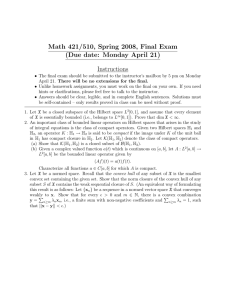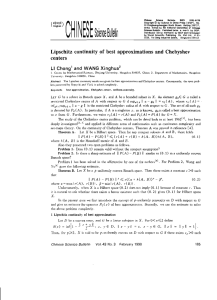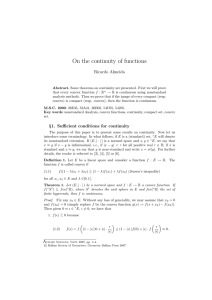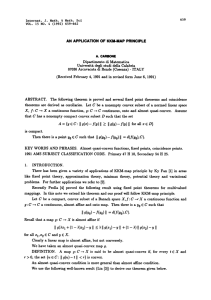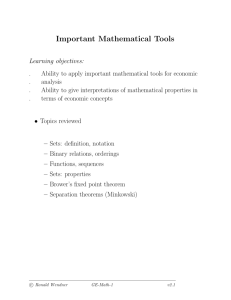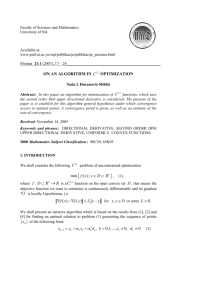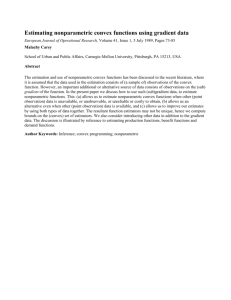tpj12685-sup-0018-AppendixS7
advertisement
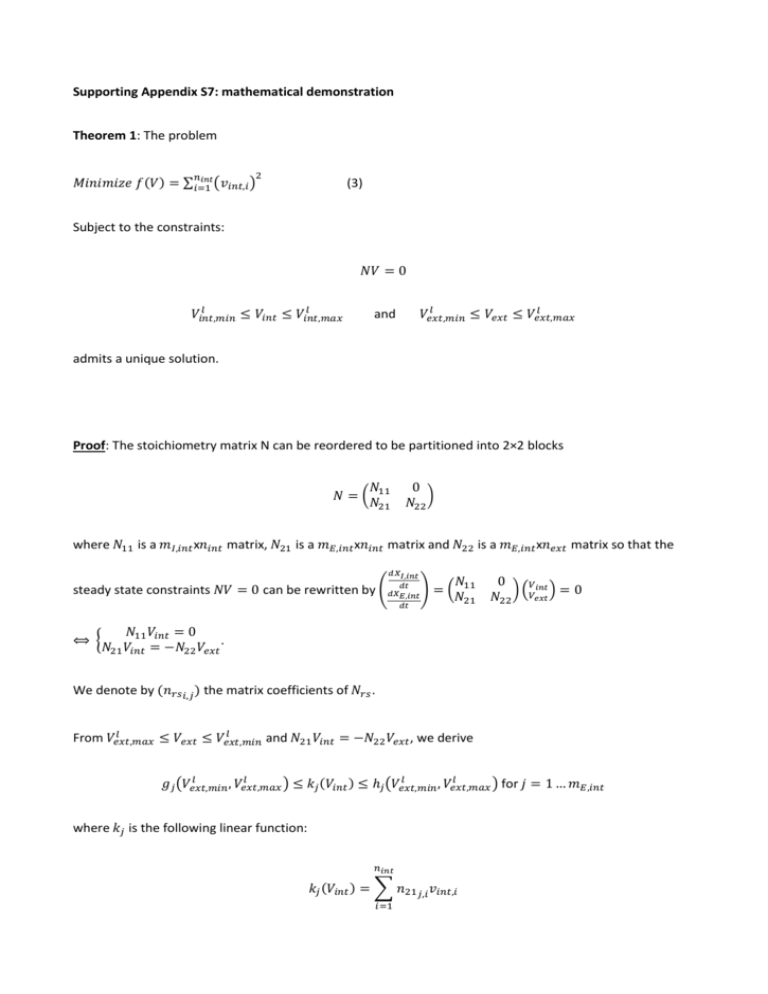
Supporting Appendix S7: mathematical demonstration
Theorem 1: The problem
𝑛
2
𝑖𝑛𝑡
𝑀𝑖𝑛𝑖𝑚𝑖𝑧𝑒 𝑓(𝑉) = ∑𝑖=1
(𝑣𝑖𝑛𝑡,𝑖 )
(3)
Subject to the constraints:
𝑁𝑉 = 0
𝑙
𝑙
𝑉𝑖𝑛𝑡,𝑚𝑖𝑛
≤ 𝑉𝑖𝑛𝑡 ≤ 𝑉𝑖𝑛𝑡,𝑚𝑎𝑥
𝑙
𝑙
𝑉𝑒𝑥𝑡,𝑚𝑖𝑛
≤ 𝑉𝑒𝑥𝑡 ≤ 𝑉𝑒𝑥𝑡,𝑚𝑎𝑥
and
admits a unique solution.
Proof: The stoichiometry matrix N can be reordered to be partitioned into 2×2 blocks
𝑁
𝑁 = ( 11
𝑁21
0
)
𝑁22
where 𝑁11 is a 𝑚𝐼,𝑖𝑛𝑡 x𝑛𝑖𝑛𝑡 matrix, 𝑁21 is a 𝑚𝐸,𝑖𝑛𝑡 x𝑛𝑖𝑛𝑡 matrix and 𝑁22 is a 𝑚𝐸,𝑖𝑛𝑡 x𝑛𝑒𝑥𝑡 matrix so that the
𝑑𝑋𝐼,𝑖𝑛𝑡
𝑁
steady state constraints 𝑁𝑉 = 0 can be rewritten by (𝑑𝑋𝑑𝑡
) = ( 11
𝐸,𝑖𝑛𝑡
𝑁21
𝑑𝑡
0
) (𝑉𝑖𝑛𝑡 ) = 0
𝑁22 𝑉𝑒𝑥𝑡
𝑁11 𝑉𝑖𝑛𝑡 = 0
⟺ {
.
𝑁21 𝑉𝑖𝑛𝑡 = −𝑁22 𝑉𝑒𝑥𝑡
We denote by (𝑛𝑟𝑠 𝑖,𝑗 ) the matrix coefficients of 𝑁𝑟𝑠 .
𝑙
𝑙
From 𝑉𝑒𝑥𝑡,𝑚𝑎𝑥
≤ 𝑉𝑒𝑥𝑡 ≤ 𝑉𝑒𝑥𝑡,𝑚𝑖𝑛
and 𝑁21 𝑉𝑖𝑛𝑡 = −𝑁22 𝑉𝑒𝑥𝑡 , we derive
𝑙
𝑙
𝑙
𝑙
𝑔𝑗 (𝑉𝑒𝑥𝑡,𝑚𝑖𝑛
, 𝑉𝑒𝑥𝑡,𝑚𝑎𝑥
, 𝑉𝑒𝑥𝑡,𝑚𝑎𝑥
) ≤ 𝑘𝑗 (𝑉𝑖𝑛𝑡 ) ≤ ℎ𝑗 (𝑉𝑒𝑥𝑡,𝑚𝑖𝑛
) for 𝑗 = 1 … 𝑚𝐸,𝑖𝑛𝑡
where 𝑘𝑗 is the following linear function:
𝑛𝑖𝑛𝑡
𝑘𝑗 (𝑉𝑖𝑛𝑡 ) = ∑ 𝑛21 𝑗,𝑖 𝑣𝑖𝑛𝑡,𝑖
𝑖=1
and 𝑔𝑗 and ℎ𝑗 are defined by
𝑛𝑒𝑥𝑡
𝑙
𝑙
𝑔𝑗 (𝑉𝑒𝑥𝑡,𝑚𝑖𝑛
, 𝑉𝑒𝑥𝑡,𝑚𝑎𝑥
)
𝑙
𝑙
= ∑ min (−𝑛22 𝑗,𝑖 𝑣𝑒𝑥𝑡,𝑚𝑖𝑛,𝑖
, −𝑛22 𝑗,𝑖 𝑣𝑒𝑥𝑡,𝑚𝑎𝑥,𝑖
)
𝑖=1
𝑛𝑒𝑥𝑡
𝑙
𝑙
𝑙
𝑙
ℎ𝑗 (𝑉𝑒𝑥𝑡,𝑚𝑖𝑛
, 𝑉𝑒𝑥𝑡,𝑚𝑎𝑥
, −𝑛22 𝑗,𝑖 𝑣𝑒𝑥𝑡,𝑚𝑎𝑥,𝑖
)
) = ∑ max (−𝑛22 𝑗,𝑖 𝑣𝑒𝑥𝑡,𝑚𝑖𝑛,𝑖
𝑖=1
∗
∗
∗ )𝑡
Then the problem (3) is equivalent to find 𝑉 ∗ = (𝑉𝑖𝑛𝑡
, 𝑉𝑒𝑥𝑡
such that 𝑉𝑖𝑛𝑡
minimizes
𝑛
2
𝑖𝑛𝑡
𝑓(𝑉𝑖𝑛𝑡 ) = ∑𝑖=1
(𝑣𝑖𝑛𝑡,𝑖 )
(4)
subject to the constraints:
𝑁11 𝑉𝑖𝑛𝑡 = 0
𝑙
𝑙
𝑉𝑖𝑛𝑡,𝑚𝑖𝑛
≤ 𝑉𝑖𝑛𝑡 ≤ 𝑉𝑖𝑛𝑡,𝑚𝑎𝑥
𝑙
𝑙
𝑙
𝑙
𝑔𝑗 (𝑉𝑒𝑥𝑡,𝑚𝑖𝑛
, 𝑉𝑒𝑥𝑡,𝑚𝑎𝑥
, 𝑉𝑒𝑥𝑡,𝑚𝑎𝑥
) ≤ 𝑘𝑗 (𝑉𝑖𝑛𝑡 ) ≤ ℎ𝑗 (𝑉𝑒𝑥𝑡,𝑚𝑖𝑛
) for 𝑗 = 1 … 𝑚𝐸,𝑖𝑛𝑡
∗
and such that 𝑉𝑒𝑥𝑡
satisfies
∗
∗
𝑁22 𝑉𝑒𝑥𝑡
= −𝑁21 𝑉𝑖𝑛𝑡
∗
Problem (4) is the optimization problem of finding some 𝑉𝑖𝑛𝑡
∈ ℝ𝑛𝑖𝑛𝑡 such that
∗
) = 𝑚𝑖𝑛{𝑓(𝑉𝑖𝑛𝑡 ); 𝑉𝑖𝑛𝑡 ∈ 𝐴𝑙 }
𝑓(𝑉𝑖𝑛𝑡
where for l=1,…,9 (corresponding to the nine stages of fruit development)
𝐴𝑙 = {
𝑙
𝑙
𝑉𝑖𝑛𝑡 ∈ ℝ𝑛𝑖𝑛𝑡 ; 𝑁11 𝑉𝑖𝑛𝑡 = 0; 𝑉𝑖𝑛𝑡,𝑚𝑖𝑛
≤ 𝑉𝑖𝑛𝑡 ≤ 𝑉𝑖𝑛𝑡,𝑚𝑎𝑥
;
𝑙
𝑙
𝑙
𝑙
𝑔𝑗 (𝑉𝑒𝑥𝑡,𝑚𝑖𝑛
, 𝑉𝑒𝑥𝑡,𝑚𝑎𝑥
, 𝑉𝑒𝑥𝑡,𝑚𝑎𝑥
) ≤ 𝑘𝑗 (𝑉𝑖𝑛𝑡 ) ≤ ℎ𝑗 (𝑉𝑒𝑥𝑡,𝑚𝑖𝑛
) 𝑗 = 1 … 𝑚𝐸,𝑖𝑛𝑡
} ⊂ ℝ𝑛𝑖𝑛𝑡
is the feasible set and 𝑓: ℝ𝑛𝑖𝑛𝑡 → ℝ is the objective function.
As 𝐴𝑙 is a compact convex subset of ℝ𝑛𝑖𝑛𝑡 (see lemma 1) and f is a strictly convex and continuous function
∗
on ℝ𝑛𝑖𝑛𝑡 , from theorem 2, this strictly convex problem admits a unique solution 𝑉𝑖𝑛𝑡
(for each 𝑙 = 1. . .9).
∗
) the augmented matrix obtained by appending the columns of 𝑁22 and
Then we denote by (𝑁22 |−𝑁21 𝑉𝑖𝑛𝑡
∗
∗
)) = 𝑛𝑒𝑥𝑡 . So
−𝑁21 𝑉𝑖𝑛𝑡
. We have 𝑟𝑎𝑛𝑘(𝑁22 ) = 𝑛𝑒𝑥𝑡 and we check numerically that 𝑟𝑎𝑛𝑘((𝑁22 |−𝑁21 𝑉𝑖𝑛𝑡
∗
∗
according to the Rouché–Capelli theorem, the linear system 𝑁22 𝑉𝑒𝑥𝑡
= −𝑁21 𝑉𝑖𝑛𝑡
admits a unique solution
∗
𝑉𝑒𝑥𝑡
(for each 𝑙 = 1. . .9) given by
∗
𝑡
𝑡
∗
𝑉𝑒𝑥𝑡
= −(𝑁22
𝑁22 )−1 𝑁22
𝑁21 𝑉𝑖𝑛𝑡
(5)
Lemma 1: 𝐴𝑙 is a compact convex subset of ℝ𝑛𝑖𝑛𝑡
Proof : Let’s denote
𝑙
𝑙
𝐴1 𝑙 = {𝑉𝑖𝑛𝑡 ∈ ℝ𝑛𝑖𝑛𝑡 ; 𝑉𝑖𝑛𝑡,𝑚𝑖𝑛
≤ 𝑉𝑖𝑛𝑡 ≤ 𝑉𝑖𝑛𝑡,𝑚𝑎𝑥
}
𝐴2 𝑙 = {𝑉𝑖𝑛𝑡 ∈ ℝ𝑛𝑖𝑛𝑡 ; 𝑁11 𝑉𝑖𝑛𝑡 = 0}
𝑙
𝑙
𝑙
𝑙
𝐴3 𝑙 = {𝑉𝑖𝑛𝑡 ∈ ℝ𝑛𝑖𝑛𝑡 ; 𝑔𝑗 (𝑉𝑒𝑥𝑡,𝑚𝑖𝑛
, 𝑉𝑒𝑥𝑡,𝑚𝑎𝑥
, 𝑉𝑒𝑥𝑡,𝑚𝑎𝑥
) ≤ 𝑘𝑗 (𝑉𝑖𝑛𝑡 ) ≤ ℎ𝑗 (𝑉𝑒𝑥𝑡,𝑚𝑖𝑛
) 𝑗 = 1 … 𝑚𝐸,𝑖𝑛𝑡 }
1. 𝐴𝑙 Is bounded because 𝐴𝑙 ⊂ 𝐴1𝑙 which is bounded.
2. ∀𝑖 = 1. .3, the subset 𝐴𝑖 𝑙 is the inverse image of a closed set and so 𝐴𝑖 𝑙 is closed. Then 𝐴𝑙 is
closed as intersection of three closed subsets 𝐴𝑖 𝑙 .
3. ∀(𝑋, 𝑌) ∈ 𝐴𝑙 , it is easy to prove that ∀𝜆 ∈ [0,1] ∀(𝑋, 𝑌) ∈ 𝐴𝑙 we also have 𝜆𝑋 + (1 −
𝜆)𝑌 ∈ 𝐴𝑙 . 𝐴𝑙 is convex
So 𝐴𝑙 is a compact convex subset.
∗
Theorem 2: The optimization problem of finding some 𝑉𝑖𝑛𝑡
∈ ℝ𝑛𝑖𝑛𝑡 such that
∗
∗
) = 𝑚𝑖𝑛{𝑓(𝑉𝑖𝑛𝑡 ); 𝑉𝑖𝑛𝑡 ∈ 𝐴𝑙 } admits a unique solution 𝑉𝑖𝑛𝑡
𝑓(𝑉𝑖𝑛𝑡
(for each 𝑙 = 1. . .9).
Proof:
The function 𝑓 is continuous and is strictly convex that is
𝑓(𝜆𝑋 + (1 − 𝜆)𝑌) < 𝜆𝑓(𝑋) + (1 − 𝜆)𝑓(𝑌) for 𝑋 ≠ 𝑌 and ∀𝜆 ∈ ]0,1[
From the Weierstrass extreme values theorem, f continuous from 𝐴𝑙 ⊂ ℝ𝑛 , 𝐴𝑙 compact (closed and
bounded) then the minimization problem 𝑚𝑖𝑛𝑓(𝑋) with 𝑋 ∈ 𝐴𝑙 admits an optimal solution with 𝑋 ∗ ∈ 𝐴𝑙 .
The optimal solution is unique. Indeed if we assume that 𝑋 ≠ 𝑌 are two minima of f in 𝐴𝑙
Then we have 𝑓(𝑋) = 𝑓(𝑌) = 𝑚𝑖𝑛 𝑓
𝑋+𝑌
)
2
But as f is strictly convex, 𝑓(
<
𝑓(𝑋)
2
+
𝑓(𝑌)
2
= 𝑓(𝑋) which leads to a contradiction.
